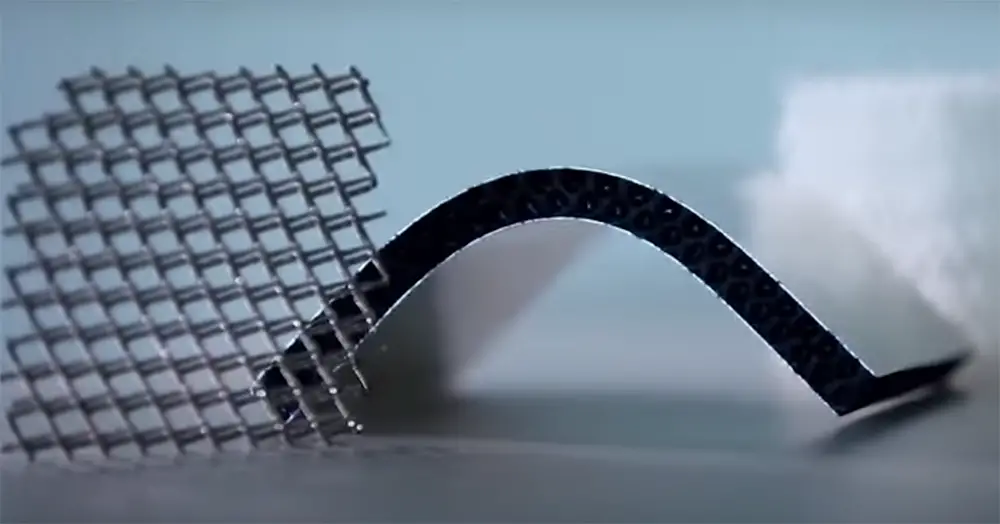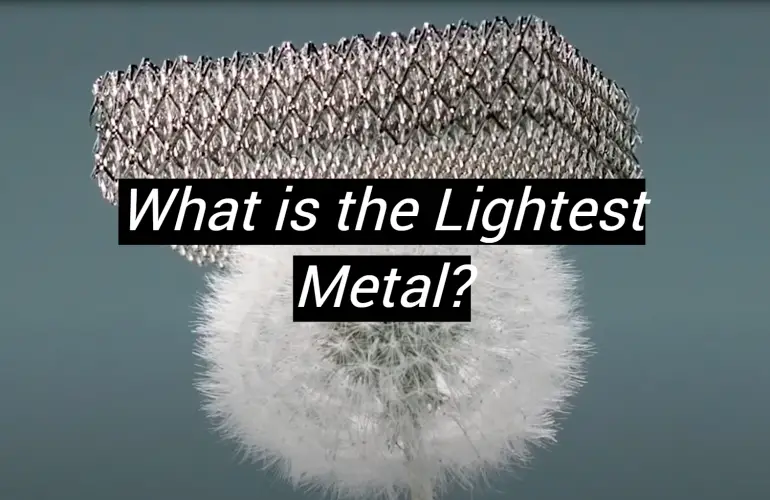There are a variety of metals in the world, each with its unique properties. Some are harder than others, some are more durable, and some are lighter than others. What is the lightest metal? This is a question that has been asked by many people over the years. In this article, we will discuss everything you need to know about the lightest metals!
List of the 10 Lightest Metals on Earth
Lithium (0.53 g/cm³)
Lithium is a silvery-white, highly reactive metal. It combines readily with different compounds to form new ones, but it also interacts easily and quickly due to its ability in chlorides or hydroxyls – which can lead lithium down an unstable path if not handled carefully by scientists who study these elements! The largest deposits are found within pegmatites (a type of rock containing minerals such as diamond).
Lithium is the lightest metal on our periodic table, meaning it has one of the lowest atomic weights. It’s used in several industries, including aviation and aerospace, where weight is always a concern. The metal is also used in batteries and other energy storage devices, lithium batteries can store more energy per unit of weight than any other type of battery.

Lithium has exceptional properties that make it ideal for use in many products. For instance, lithium’s melting point is higher than any other metal on Earth and its thermal conductivity makes the batteries of cars or power plants able to withstand high temperatures without fail[1].
Potassium (0.89 g/cm³)
Potassium is the second lightest metal on Earth with a density of 0.89 g/cm³, and it can be found in many minerals, including sylvite (a crystal), carnallite (an ore), and langbeinite.
Potassium is one of the most important metals in our world. It has a wide range and variety of uses, such as fertilizers for plants[3]. The low melting point makes it perfect not just for glassmaking, but also for welding [4].
Potassium is also known for its high electrical conductivity, making it an important component in some electronic products [5]. The metal is also used in the production of some alloys and as a heat-treatment agent.
Sodium (0.97 g/cm³)
In third place, we have sodium, with a density that’s just under one gram per cubic centimeter, and it’s also highly reactive! You can find this soft silvery-white metal in many minerals like rock salt or halite (soda) too, but when you look at its elemental form all that happens is reactivity kicks into high gear – it goes boom if exposed to water ever so slightly.
The metal has a wide range of uses, the most important being in sodium-chloride (table salt). It’s also used for making glass and soap as well as dyes to color textiles such cotton clothes or wool sweaters [6]; its high electrical conductivity makes them a key component during some electronic product manufacturing processes like cell phone charges [7].
Rubidium (1.53 g/cm³)
Next on our list is rubidium, with a density that’s just over one and a half grams per cubic centimeter. It can be found in small quantities throughout many rocks or minerals.
The metal has a wide range of uses, the most important being in rubidium-based lasers. These are used in fiber optic communications and other applications. Rubidium is also used in alloys and glassmaking, as well as in atomic clocks, as it has the longest known natural radioactive decay half-life of any element [8].
Calcium (1.54 g/cm³)
Rounding out the top five is Calcium. This metal is found in a number of different minerals, including limestone, dolomite, and gypsum.
Due to its unique traits, calcium has a wide range of uses, the most important being in calcium-based alloys. These are used in many applications such as construction, automotive, and aerospace industries. Calcium is also used in glassmaking, ceramics, and metallurgy.

Magnesium (1.74 g/cm³)
Magnesium is one of the lightest metals, with a density of just over one and three-quarters grams per cubic centimeter. The largest deposits are usually found in dolomite or magnesite rocks.
Magnesium is a key ingredient in the production of lighter and more fuel-efficient vehicles. It can also be used for electronic products like laptops or mobile phones, construction, aerospace, and chemical manufacturing [10].
Magnesium is an essential mineral for the body. It’s involved in many important chemical reactions, including energy production and protein synthesis!
Beryllium (1.85 g/cm³)
Beryllium is a metal found mostly in minerals like bertrandite and emerald. It has unique properties that allow it to absorb X-rays, making it an important component for x-ray machines as well as for other medical equipment such as measuring devices used by doctors during surgeries or examinations of people’s bodies. Alloys containing this precious resource can also be found being used within electronics because of how highly conducting they are when compared with most metals out there today!
Beryllium exposure can be dangerous as it can lead to respiratory diseases. Therefore, care must be taken when handling this metal [11].
Cesium (1.93 g/cm³)
Cesium is an extremely light metal with the eighth-lightest density in Earth’s crust. The most commonplace cesium deposits are in pollucite or lepidolites, but this reactive element can also be found within other minerals such as rubies.
Cesium is used in different applications, the most important being in atomic clocks. Cesium is also used in television tubes, photoelectric cells, and electron microscopes. The metal is also used in certain alloys and as a getter in vacuum tubes [12].
Due to its radioactivity, cesium must be handled with care. Exposure to this metal can lead to many health problems, including cancer.
Strontium (2.64 g/cm³)
The ninth lightest metal on Earth is Strontium, which can be found in several minerals, including strontianite and Sr-rich apatite.
There are many ways to use strontium. For example: in the production of cathode-ray tubes. However, this metal has other uses, including in alloys, ceramics, and glassmaking. Strontium is also used as a getter in vacuum tubes and as a colorant in fireworks[13].
Aluminum (2.71 g/cm³)
Aluminum is a metal that’s found in nature as hydrated minerals like gibbsite and boehmite. It has many uses, but one of its most important ones is for making alloys with other metals to create materials with improved properties such as strength or resistance against corrosion-inducing environments.
The advantages of this material make it ideal for a variety of applications. One of the most unusual properties of aluminum is that it’s highly reflective [14]. That makes it ideal for use in reflectors and mirrors. More than half of all the aluminum produced each year is used in these applications. Aluminum foil is widely used in food packaging, insulation, and electrical applications. It is also used in a variety of other industries, including automotive and construction.
Lightest Elemental Metals
There are a variety of different elemental metals, but the lightest of them all is lithium. Elemental metals are those that exist in nature in their purest form, and lithium is no exception. Lithium is classified as a “light metal” because it has one of the lowest densities of any element. This means that it’s not only light in weight, but also has a very low atomic mass. When compared to other elements on the periodic table, lithium is more than twice as light!

Lightest Metal Alloy
Alloys are often created to improve upon the properties of individual metals. For example, steel is an alloy that contains iron and carbon in addition to other elements such as manganese or nickel for added strength compared with either element alone.
There are many different alloys of metals, but some of the most common include aluminum, brass, bronze, copper, and steel. Each alloy has its own unique set of properties that can be advantageous in certain applications. For example, aluminum is often used in aircraft because it is lightweight yet strong. Steel is commonly used in construction because it is exceptionally strong and durable.
Usually, the lightest metal alloy is going to be some sort of aluminum. This is because aluminum alloys typically have a density of around 2700 kg/m³ [15]. However, other metals can be just as light or even lighter. One example is magnesium which has a density of only 1740 kg/m³ [16]. There are also other alloys such as titanium-aluminum and lithium-aluminum that can have densities lower than 2000 kg/m³.
FAQ
What is the lightest metal in the world?
The lightest metal is lithium with a density of only 0.53 g/cm³.
Which is the lightest and heaviest metal?
The lightest metal is lithium with a density of only 0.53 g/cm³. The heaviest metal is osmium with a density of 22.59 g/cm³.
What is the lightest metal but strongest?
There is no definitive answer to this question since there are many different types of metals and alloys with different properties. Some examples of strong, lightweight metals include aluminum, titanium, and magnesium.
Is Mercury the lightest metal?
No, mercury is not a metal. It is a liquid at room temperature and has a density of 13.59 g/cm³.
What is the lightest material?
The lightest material is aerogel with a density of only 0.001 g/cm³.
Is Aluminum the lightest metal?
No, aluminum isn’t the lightest metal. In fact, magnesium is actually the lightest metal on Earth. Aluminum is still a lightweight material though, which makes it a popular choice for many industrial and recreational applications. It’s also highly resistant to corrosion, so it’s often used in long-term projects or products that need to last and stand up to wear and tear. So when you need a strong yet lightweight material that won’t break your budget, aluminum could be just what you’re looking for.
What’s the most unbreakable material?
The most unbreakable material is actually diamond. Diamonds are incredibly hard and durable, making them almost impossible to destroy or break. In fact, the only way to really damage a diamond is by using industrial-grade diamond-cutting tools, which can chip away at its surface. They’re also incredibly resistant to heat, so they won’t melt or deform no matter how hot it gets. So if you’re looking for an indestructible material, then diamonds may be your best bet!
Is titanium lighter than aluminum?
No, titanium is actually heavier than aluminum. Titanium has the highest strength-to-weight ratio of any naturally occurring metal, so it’s often used in aircraft and other applications where light weight is important. However, because it’s so dense, titanium also weighs more than aluminum. On a volume basis, titanium is about 60% denser than aluminum. This means that for an equal volume, a titanium object will weigh around 60% more than its aluminum counterpart. Ultimately this means that while titanium can be strong and lightweight at the same time, it will still have more mass than an equal size object made from aluminum.
Additionally, compared to other metals like steel or iron, titanium is one of the lightest materials available!
Is titanium lighter than steel?
Yes, titanium is lighter than steel. The density of steel is 7.85 g/cm3 while that of titanium is 4.51 g/cm3. This means that titanium is almost half the weight of steel in terms of volume. Additionally, its strength-to-weight ratio is much higher than that of steel, making it ideal for use in aerospace and automotive applications. However, it is also more expensive than steel due to its rarity. Therefore, depending on the particular application and budget considerations, either one may be more suitable than the other.
Is titanium really light?
Yes, titanium is indeed light! It weighs about 60% of what steel does, making it much lighter than many other metals. Its low weight means that it can be used in a wide variety of applications where lightweight materials are preferred. Its strength-to-weight ratio makes it one of the most desirable metals among engineers and industrial designers.
What is lighter than aluminum but stronger?
Magnesium is lighter than aluminum but stronger. Magnesium is the eighth-most-abundant element in the universe and can be found naturally in seawater, minerals, and various plants. It’s often used to create lightweight aircraft parts, due to its lower density and strength. Magnesium is also a great heat conductor, making it perfect for electronic components. Plus, it’s corrosion-resistant and recyclable, making it a great choice for sustainable projects. So if you’re looking for something lighter than aluminum but still strong, try magnesium!
What is the 2nd lightest metal?
The second lightest metal is lithium, with a density of 0.534 g/cm³. It is the lightest alkali metal and is highly reactive in air, reacting vigorously to form lithium oxide and other compounds. Lithium has a wide range of uses, including batteries for electronics such as cell phones and laptops, alloys, medicines, and nuclear reactors. It is also used as an alloying agent in aluminum and magnesium alloys to reduce weight and improve strength. Ultimately, lithium’s low density and high reactivity make it an important component of many products across a wide range of industries.
Other light metals include beryllium (1.848 g/cm³), magnesium (1.738 g/cm³) and aluminum (2.699 g/cm³). All of these metals are used in a variety of applications, such as aerospace construction, electronics, automotive components and various alloys. Beryllium is also very lightweight and has a very high melting point, making it useful in applications where low weight and superior thermal properties are desired. Magnesium is a strong metal with good stiffness, ductility, and impact strength. It is also more corrosion-resistant than aluminum and cheaper than titanium, making it desirable for many projects. Aluminum is lightweight yet sturdy, with excellent electrical conductivity and corrosion resistance. It is an integral component in many products and projects, from aircraft to wind turbines.
Useful Video: Lithium – The Lightest Metal on Earth
Final words
So, what is the lightest metal? It turns out that there are quite a few contenders for this title, and each has unique advantages that make it perfect for certain applications. But when it comes down to it, the answer depends on how you measure “lightness”. If you consider density to be the most important factor, then aluminum takes the crown. However, if you weigh other factors such as strength-to-weight ratio or corrosion resistance, then some of the newer metals may come out on top. In any case, the field of lightweight metals is constantly evolving, even lighter metals will likely be developed, making them an increasingly important part of our lives.
References:
- https://www.rsc.org/periodic-table/element/3/lithium
- https://www.webmd.com/bipolar-disorder/guide/bipolar-disorder-lithium
- https://www.frontiersin.org/articles/10.3389/fpls.2020.00904/full
- https://www.vynova-group.com/blog/potassium-derivatives-glass
- https://www.britannica.com/science/potassium
- https://austinpublishinggroup.com/textile-engineering/fulltext/arte-v6-id1061.pdf
- https://www.science.org/content/article/sodium-batteries-are-one-step-closer-saving-you-mobile-phone-fire
- https://www.researchgate.net/publication/235178088_The_Rubidium_Atomic_Clock_and_Basic_Research
- https://www.hsph.harvard.edu/nutritionsource/calcium/
- https://www.rsc.org/periodic-table/element/12/magnesium
- https://www.osha.gov/beryllium
- https://www.lenntech.com/periodic/elements/cs
- https://earthsky.org/human-world/how-do-fireworks-get-their-vibrant-colors/
- http://rmico.com/bare-aluminum
- https://www.thyssenkrupp-materials.co.uk/density-of-aluminium.html
- https://www.lenntech.com/periodic/elements/mg






